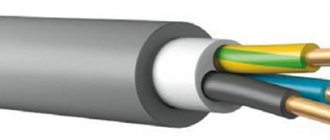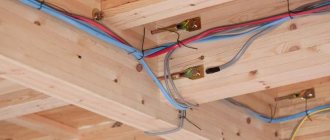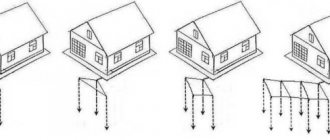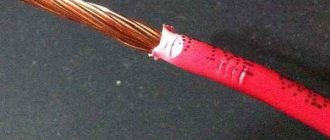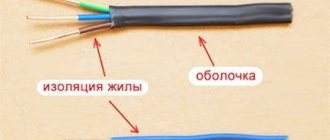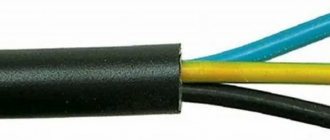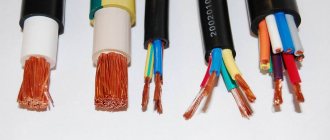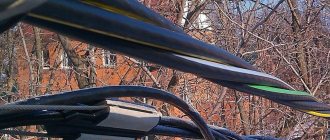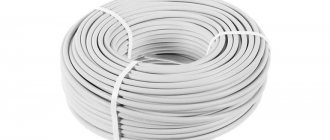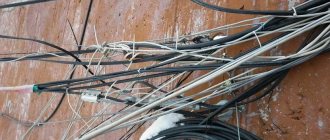Physically, an electrical cable is an assembly consisting of one or more conductors with their own insulation, additional shielding, assembly protection, and an overall protective covering. A conductor (core) is a material that can transmit electricity through itself. The most commonly used conductors in cables are copper and aluminum. These metals are characterized by good electrical conductivity and long service life. Another advantage of these conductors is that they are recyclable. That’s why today the question of where to scrap a cable in Moscow is so popular. End-of-life electrical cables and wires can bring material income to those who collect and sell them, as well as reduce the cost of energy consumption in the production of primary conductor metals.
Prices for cable reception
| Cable type | Price per kg, rub. |
| Copper cable 1.5-4 square | 70-150 gross or up to 320 for contents. |
| Copper cable from 6 square | 300-330 copper yield |
| Internet cable (twisted pair, utp), telephone cable in plastic | 80-140 gross or up to 320 for contents. |
| Coaxial cable (corrugated feeder, thin ones are not accepted) | 300-360 copper yield |
| Power cable (contact) | 305-370 for copper yield |
| Copper cable with lead sheath | 120-160 gross |
| Aluminum cable with lead sheath | 45-55 gross |
| Aluminum cable (power) | 60-80 for aluminum yield |
Properties of electrical conductors
Electrical conductors have mobile electrically charged particles, which in metals are called "electrons". The moment an electric charge interacts with a metal, its electrons begin to move and transmit electricity. Metals with high electron mobility are good conductors, while metals with low electron mobility are used as insulators. Various conductors are used in electrical wiring and in the manufacture of electrical cables, but copper and aluminum continue to be the most common. These can be used to produce:
- Single-core cables, which, as the name suggests, have one conductor or strand that carries the electric current, as well as an insulating layer that protects against short circuits and electric shocks.
- Stranded is a combination of several single-core electrical wires that have one insulating and protective layer.
Copper conductors: copper is one of the oldest metals mastered by mankind. Copper was used by Ben Franklin and Michael Faraday in their experiments with electricity, and was first used in inventions such as the telegraph, telephone and electric motor.
With the exception of silver, copper is considered the most common conductive metal and became an international standard, which was adopted in the 13th century. The international standard was created for the purpose of comparing other copper conductors. According to it, annealed pure copper has 101% IACS conductivity.
In addition to excellent conductivity, this metal has characteristics such as tensile strength, thermal conductivity and lack of thermal expansion. Advantages of copper cables:
- Low resistance.
- Excellent ductility – elongation of molar alloy from 20 to 40%.
- High strength at high temperature stresses.
- The flexibility of copper is 1.8 times higher than aluminum - this suggests that cables with a copper core are more resistant to bending.
- Good stability and corrosion resistance.
- High current carrying capacity: Due to its low resistivity, copper cable has a cross-section that is approximately 30% larger than the permissible current carrying capacity of aluminum cable.
- Low voltage loss.
- Low power consumption: Since the resistance of copper cable is lower than aluminum cable, its power loss is also lower.
- Resistance to creep - deformation of a metal under the influence of a changing load. Copper is resistant to expansion and contraction, so its connections do not weaken and therefore do not overheat or spark.
Criteria for choosing wisely
The key to uninterrupted operation of the home electrical system is the quality of components. Therefore, at the stage of purchasing them, one of the key tasks is to choose a cable of appropriate quality.
Manufacturers always indicate what metals the cores are made of and what materials are included in the insulation braid; these parameters are indicated in the cable marking
To help you choose the right cable, you need to carefully study the product labeling. The cable must indicate: brand, manufacturer's name and compliance with GOST or technical specifications. The cross-sectional size and grade of the cable must be repeated at equal intervals along the entire length of the outer braid of the product.
The marking of any electrical cable is represented by numbers and three letters.
The first digit of the numerical designation determines the number of cores, the second digit – the cross-sectional area of each of them, the third – the calculated network voltage. The remaining numbers indicate the flexibility class of the cord. The first letter determines the type of material used to create the top braid of the insulation.
If you have a product in front of you that has the letter “A” in the first place in its marking, this means that the cores are made of silver metal – aluminum; if such a letter is missing, the threads are made of copper
The second letter indicates the wire type:
- " K " - control;
- " P " - flat;
- " M " - mounting;
- “ Ш ” or “ У ” - installation;
- " Mg " - mounting with a flexible core.
The third letter of the marking determines the material used for internal insulation of the cores.
Options for its designation and decoding:
- “ P ” - insulation is made of polyethylene;
- “ B ” or “ BP ” - the braid is made of rubber;
- “ Pv ” - vulcanizing polyethylene is used;
- “ Ps ” - self-extinguishing polyethylene is used;
- “ C ” - the outer braid is made of lead;
Rubber insulation can be protected by a nayrite sheath “ N ” or polyvinyl chloride “ B ”.
An example of decoding the designation: VVG 4x2.5-380 - a cable with four copper cores with a cross-sectional area of 2.5 mm, designed for a voltage of 380 V, insulated with PVC braiding and enclosed in an outer PVC sheath
The next letter indicates the type of cable: “ NG ” - non-flammable and fire-resistant, “ B ” - armored, “ LS ” - does not emit smoke when melted. Products with an armored shell are used where there is a possibility of mechanical damage.
The presence of the letter “ E ” in the marking indicates that there is filler between the cores. The letter combination “ OZH ” indicates that this is a single-wire conductor.
Cables with aluminum core
Although copper has high throughput, flexibility, and low creep resistance, aluminum has some important advantages. This metal has 61% of the conductivity of copper, while it is 30% lighter than its competitor - this means that a bare aluminum wire will weigh half as much as copper with a similar electrical resistance. Aluminum is a cheaper conductor than copper, and when using aluminum cables there is no current fluctuation that usually occurs due to conductor resistance. Due to their light weight, aluminum wires are often used when installing high-voltage overhead power lines, as they require fewer support towers.
In addition to the above conductors, other metals such as gold, silver, tungsten and alloys can be used in the production of cables. Each of them has its own advantages and disadvantages and is used depending on the purpose of the cable.
Types of installation wires
The following types are suitable for installation work:
- RKGM is a heat-resistant copper cable that can withstand up to 660 V and up to 400 Hz. The rubber insulation is covered with fiberglass impregnated with varnish. Can operate at -60…+180 °C.
- PNSV - core made of galvanized or blued steel, the insulation is heat-resistant, retains its properties at -50...+80 °C. Provides voltage transmission up to 380 V, is resistant to the negative effects of alkali and even withstands immersion in water.
- VPP - copper stranded conductor, double PVC and polyethylene insulation. Designed to operate in networks up to 380 V, withstands large pressure drops and temperatures -40...+80 °C. Such cables are suitable for connecting an electric motor immersed in an artesian well.
Insulators
Insulators are synthetic materials that are used to insulate electrical wires and perform the following protective functions:
- from electric shock;
- from mechanical damage;
- from moisture;
- against the harmful effects of various substances.
The insulation in the cables has its own marking, thanks to which you can immediately determine what type of material we are dealing with. Most often used for insulation:
- regular tires G;
- silicone gum Gs;
- Halogen-free material N or H;
- cross-linked polyethylene XS;
- organofluorine plastic Zb;
- multivitamin coating Y;
- heat-resistant polyvinyl coating Yc.
Cables subject to high mechanical loads that can destroy the insulation are additionally protected and reinforced with metal armor. Armor can be made of galvanized steel, bronze or aluminum. It is used both for screen (signal insulation of power cables) and for internal or external insulation.
Cord
You can often hear the phrase “ electrical cord ,” although how it differs from a cable or wire is not always clear. A cord is a wire consisting of two or more stranded flexible cores, each of which is enclosed in insulation, covered on top with a protective sheath of soft plastic or rubber. In older samples, the outer shell is made of synthetic threads.
Grounding cord and plug
Cords are used in household appliances because they have increased softness and flexibility compared to cable or regular wire. The cord can be twisted and bent without the risk of damaging the cores and insulation. Devices that use grounding during operation usually have cords with more than two cores. These are washing machines, vacuum cleaners, kettles and power tools. Two wires are used where grounding is not necessary. These are lighting devices: sconces, lamps, etc.
These articles may also be of interest to you:
- Wire routing
- Wire connection methods
- Selecting a cable for electrical wiring
- Wire characteristics
Recycling after use
Despite the long service life of the cables (from 15 to 30 years), they all need to be replaced after this period has expired. After this, the cables must be disposed of and recycled. Searching for wires and delivering them to scrap metal collection points allows us to partially solve the problem of obtaining primary raw materials. Collection points accept scrap:
- household;
- control;
- power;
- special cables.
The price per kilogram of scrap is determined:
- The quality of supplied raw materials.
- The percentage of a particular metal.
- Purity – the amount of contaminants and oxides.
- The integrity of the sheath, as well as the complexity of further processing of cable scrap.
- Volume of recyclable materials - the more cable scrap is handed over, the higher the price per kilogram.
Lead.
The main characteristic of a metal such as lead is its high resistance to corrosion. It is this feature, which is possessed by almost all metals in the energy sector, that determined the scope of use of lead in this industry. Typically, lead is used to make batteries and is also used to make sheaths for cable products.
The lead cable sheath has the form of a solid pipe, which in addition to the lead itself includes:
- antimony – from 0.15 to 0.3%;
- copper – up to 0.06%;
- tellurium – up to 0.005%;
- tin – from 0.35 to 0.5%.
The advantages of lead used for the manufacture of cable sheaths include:
- high melting point - 327.4 degrees;
- high tensile strength of cast lead – 95 kgf/cm2;
- high resistance of lead to corrosion;
- low chemical activity.
But lead sheaths also have their disadvantages, including:
- high density – 11.34 g/cm3;
- low resistance to vibrations, especially if these vibrations occur at high temperatures;
- low lead production - in other words, not enough lead.
It is because of these shortcomings that engineers began to look for other metals that could be used to make cable sheaths. And aluminum became one of the best “substitutes” for lead.
Foreign manufacturers
If you see Latin letters in the code on the insulation, it means the product is from a foreign company.
Their power cables are designated as follows:
- N – manufactured according to the standards of the Union of German Electricians VDE;
- Y – in our opinion – vinyl;
- H – no dangerous inclusions such as halogens;
- M – conductor for installation.
For control:
- Y – insulated using vinyl;
- SL – for control;
- Li – many cores are made according to VDE.
For installation:
- H – HAR approved;
- N – meets the standards of the country of manufacture;
- 05 – maximum permissible U = 500 V;
- 07 – maximum permissible U = 750 V;
- V – insulated with vinyl;
- K – the core bends well, recommended for installation work.
Foreign markings differ little from domestic ones, but the symbols may be positioned differently, be careful and consult with specialists.
Aluminum.
In the manufacture of sheaths for cable products, aluminum has shown a number of advantages compared to lead:
- aluminum is lightweight - it is 4 times lighter than lead;
- At the same time, aluminum shells are mechanically more stable than lead shells, and this makes it possible not to use any special materials that increase the mechanical strength of the metal in their manufacture;
- aluminum is vibration resistant;
- the strength of aluminum is only 2.7 g/cm3;
- The melting point of aluminum is 657 degrees.
Thus, a cable sheath made of aluminum has a smaller diameter and weight, which makes it possible to increase the length of the cable itself. In addition, the high mechanical stability of aluminum makes it possible to avoid the use of a special armor shell in the manufacture of the cable. But the aluminum shell also has its drawback - it has poor resistance to electromechanical and soil corrosion. That is why, when making a cable in an aluminum sheath, additional protection from bitumen, PVC tapes or hoses, rubberized fabric or paper is used. A cable with such protection can last for decades.
In addition to the manufacture of sheaths for cable products, aluminum is also used for the manufacture of cables themselves - cable cores with a central channel are made from it. True, the manufacture of such a cable is associated with some technological difficulties due to the qualitative characteristics of aluminum, such as the need to remove the oxide film from the surface of the aluminum wire and problems that arise when welding aluminum wire. In addition, a cable with aluminum conductors, as a rule, has a fairly large diameter, which does not allow laying long cable lines without the use of connecting couplings.
And in order to avoid these difficulties, another metal is used for the manufacture of cable cores - copper.
Popular markings
A popular type of cable is VVG - read: Vinyl, Vinyl, Naked. If we look at all the letters in more detail, we get:
_ the first character is missing, which means the core is made of electrical copper.
B – the insulation of each core is made of PVC.
B - all the veins are surrounded by a common dense polyvinyl chloride layer.
G - bare, that is, there is no armor on top of the common shell - a vandal-proof rigid structure.
The VVG cable has from one to five current-carrying parts. It may have a zero core or be missing.
If the cable is marked VVGng, this means that this subtype of product does not support the spread of fire. This quality is important for places with an increased risk of fire.
More complete marking: cable VVGng - 0.66 kV 3*1.5. The product is copper, made of three cores, each with a cross-section of 1.5 mm2. Each is insulated with PVC (first symbol B), the overall shell is also vinyl (second symbol B), there is no armor (letter G), and does not support combustion when in a group (letter ng).
PVA copper cable is often purchased for electrical wiring in private homes, for various equipment in the country, for connecting any kitchen appliances and machines to the network.
The PVA marking stands for: copper wire, connecting, with PVC insulation. Such a wire is made of 2-5 copper, twisted, separately covered with PVC cores, with different cross-sections (0.5-22 mm2).
The wires on the poles are designated as follows:
- SIP-1 – self-supporting cross-linked polyethylene insulated wire with an uninsulated zero;
- SIP-2 – the neutral core is insulated;
- SIP-4 - insulated conductors with the same cross-section.
NYM wires – manufactured according to German Normenleitung cable standards, in PVC (Y), used in installation for various purposes. VDE symbols guarantee uninterrupted operation in areas with high temperatures and fire hazard areas.
KG – flexible cable is produced with copper round conductors, from one to five, with a wide range of cross-sections: from 1 to 185 mm2. The core insulation consists of rubber based on natural rubber (RTI-1). The general shell is hose rubber RShT-2 or RShTM-2 made of synthetic rubber (isoprene, butadiene).
